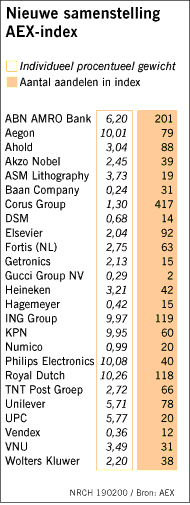Amundi DJIA UCITS ETF (Dist): How To Interpret Net Asset Value

Table of Contents
What is Net Asset Value (NAV) in the context of the Amundi DJIA UCITS ETF (Dist)?
The Net Asset Value (NAV) of the Amundi DJIA UCITS ETF (Dist) represents the intrinsic value of a single share in the fund. Unlike individual stocks traded throughout the day, an ETF's NAV is calculated at the close of the market. Because this ETF tracks the Dow Jones Industrial Average (DJIA), its NAV is directly tied to the performance of the 30 major US companies comprising the index. Think of it as the total value of all the DJIA stocks held by the fund, minus any liabilities (like management fees), divided by the total number of outstanding shares.
- NAV represents the intrinsic value of a single ETF share. This value reflects the underlying assets' worth.
- It fluctuates daily based on the market value of the underlying DJIA stocks. If the DJIA goes up, so will the NAV; conversely, a decrease in the DJIA will usually lead to a decrease in NAV.
- NAV is usually published daily by the ETF provider (Amundi). This makes it easily accessible to investors. The calculation reflects the closing prices of the constituent stocks.
Where to Find the Amundi DJIA UCITS ETF (Dist) NAV?
Accessing the daily NAV for the Amundi DJIA UCITS ETF (Dist) is straightforward. Several reliable sources provide this essential information:
- Amundi's official website: The ETF provider's website is the most accurate and reliable source for NAV data. Look for the dedicated ETF section, usually under "Funds" or "Products."
- Major financial news websites and data providers (e.g., Bloomberg, Yahoo Finance): Many reputable financial websites display real-time or end-of-day NAV data for various ETFs, including the Amundi DJIA UCITS ETF (Dist). Simply search for the ETF's ticker symbol.
- Your brokerage account platform: Most brokerage platforms provide real-time or delayed NAV information for the ETFs you hold in your portfolio. Check your account statements or the fund's details page.
Always verify the source's reliability before making any investment decisions based on the NAV information.
How to Interpret NAV Changes in the Amundi DJIA UCITS ETF (Dist)?
Changes in the NAV of the Amundi DJIA UCITS ETF (Dist) directly reflect the performance of the underlying Dow Jones Industrial Average. A rising NAV indicates positive performance, meaning the DJIA's component stocks have generally increased in value. Conversely, a falling NAV suggests negative performance.
It's important to understand the difference between NAV and market price. While they usually track closely, minor discrepancies can exist due to intraday trading. The market price fluctuates throughout the trading day, while NAV is calculated at the close of the market.
- An increase in NAV indicates positive performance. This usually aligns with an increase in the DJIA.
- A decrease in NAV signals negative performance. This typically mirrors a decline in the DJIA.
- Factors influencing NAV changes: Market movements are the primary driver, but dividends distributed by the underlying companies and the ETF's expense ratio also play a minor role in affecting the NAV.
Using NAV to Make Informed Investment Decisions with the Amundi DJIA UCITS ETF (Dist)
Regularly monitoring the NAV of the Amundi DJIA UCITS ETF (Dist) is crucial for effective portfolio management. By tracking NAV changes over time, you can assess the performance of your investment against the benchmark (the DJIA itself). This allows you to evaluate the ETF's tracking accuracy and make informed decisions about buying, selling, or holding.
- Compare NAV with previous periods to assess performance: Tracking NAV trends over weeks, months, or years helps identify long-term performance patterns.
- Use NAV to determine when to buy or sell (considering other factors too): While NAV is a vital indicator, consider other market factors, risk tolerance, and investment goals before making buy/sell decisions.
- Track NAV alongside the DJIA to assess the ETF's tracking accuracy: A well-performing ETF will closely mirror the movements of its benchmark index.
Conclusion: Making Informed Decisions with Amundi DJIA UCITS ETF (Dist) NAV
Understanding and interpreting the Net Asset Value (NAV) of the Amundi DJIA UCITS ETF (Dist) is essential for any investor. By regularly checking the NAV from reliable sources and understanding its relationship to the Dow Jones Industrial Average, you can effectively monitor your investment’s performance and make informed decisions aligned with your investment strategy. Remember to consider NAV in conjunction with other market indicators and your overall financial goals. Regularly review your Amundi DJIA UCITS ETF (Dist) holdings and explore other Amundi ETFs or investment options to diversify your portfolio further. Stay informed about your investments and make well-informed decisions using the power of NAV data!

Featured Posts
-
 The Roots Of Trumps Harsh Rhetoric On European Trade
May 25, 2025
The Roots Of Trumps Harsh Rhetoric On European Trade
May 25, 2025 -
 Marktdynamiek Europese Aandelen En Wall Street Een Vergelijking
May 25, 2025
Marktdynamiek Europese Aandelen En Wall Street Een Vergelijking
May 25, 2025 -
 Herstel Op Beurzen Na Uitstel Trump Alle Aex Fondsen In Het Groen
May 25, 2025
Herstel Op Beurzen Na Uitstel Trump Alle Aex Fondsen In Het Groen
May 25, 2025 -
 Bbc Radio 1 Big Weekend 2025 Tickets A Step By Step Guide Full Lineup
May 25, 2025
Bbc Radio 1 Big Weekend 2025 Tickets A Step By Step Guide Full Lineup
May 25, 2025 -
 Penzionerski Raj Luksuzan Zivot I Milionska Imovina
May 25, 2025
Penzionerski Raj Luksuzan Zivot I Milionska Imovina
May 25, 2025
